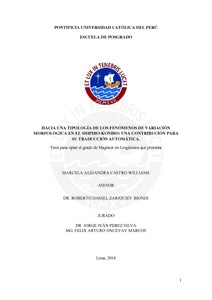| dc.contributor.advisor | Zariquiey Biondi, Roberto Daniel | |
| dc.contributor.author | Castro Williams, Marcela Alejandra | es_ES |
| dc.date.accessioned | 2018-08-27T16:31:25Z | es_ES |
| dc.date.available | 2018-08-27T16:31:25Z | es_ES |
| dc.date.created | 2018 | es_ES |
| dc.date.issued | 2018-08-27 | es_ES |
| dc.identifier.uri | http://hdl.handle.net/20.500.12404/12484 | |
| dc.description.abstract | La lengua shipibo-konibo (SK) es una de las más grandes de la Amazonía peruana.
Debido a su numerosa población vernácula que alcanza los 23.000 hablantes, fue
favorecida por un proyecto que busca proveer a las lenguas minoritarias del Perú de
herramientas computacionales. Desarrollado en el marco del proyecto del Fondo
Nacional de Desarrollo Científico Tecnológico y de Innovación Tecnológica
(FONDECYT), la iniciativa tiene como meta desarrollar una plataforma para la
traducción automática desde el shipibo-konibo al castellano y viceversa. Este proyecto
llamado Chana, ha formado un equipo interdisciplinario de ingenieros y lingüistas con el
objetivo de desarrollar el software y corpus necesario para implementar dicho traductor.
En este contexto, la presente investigación propone una tipología que describe la lengua
para los fines prácticos de la traducción automática y con ella, ayudar a la solución de
problemas que se presentarán en el nivel de programación morfológico del traductor. La
tipología expuesta busca clasificar las variaciones alomórficas en cuatro frentes, primero
en su nivel lingüístico de condicionamiento en que se presenta la alomorfía, luego ofrece
el número de variaciones formales que alcanza en el SK, también menciona el nivel de
predictibilidad de dichas variaciones y finalmente describe la semejanza formal entre los
alomorfos de un morfema. Estos elementos permitirán a los ingenieros del proyecto
identificar las alomorfías por medio del inventario entregado y recomendar algunos
ajustes que creo necesarios se deberán considerar en la programación en el nivel
morfológico del TA y que servirán para solucionar los problemas cuando el traductor en
línea deba traducir desde castellano al SK. | es_ES |
| dc.description.abstract | The Shipibo-Konibo (SK) language is one the largest ones in the Peruvian Amazonia.
Due to its numerous vernacular population that reaches 23,000 speakers, it was favored
by a project which seeks to provide some minority languages in Peru with computational
tools. Developed under the framework of the project of the Fondo Nacional de Desarrollo
Científico Tecnológico y de Innovación Tecnológica (FONDECYT), the initiative has as
goal to develop a platform for a machine translation (MT) from Shipibo-Konibo to
Spanish and vice versa. This project called Chana has formed an interdisciplinary team
of engineers and linguists with the goal of developing the necessary software and corpus
for the implementation of such translator. In this context, the present investigation
proposes a typology that describes the language with practical purposes for automated
(MT) and, with this, help to solve problems that will come up at the level of the
morphological programming of the translator. The typology exposed here looks to
classify the alomorphic variations in four fronts, first the linguistic level of conditioning
in which the allomorphy presents itself, then it offers the number of formal variations that
reaches in the SK, it also mentions the level of predictability of such variations and finally
it describes the formal similarity between the allomorphs of a morpheme. These elements
will allow the engineers of the project to identify the allomorphies through the delivered
inventory and to recommend some adjustments that I see necessary to be considered in
the programming at the morphological level of the MT and that will be useful to solve the
problems when the online translator should translate from Spanish to SK. | es_ES |
| dc.description.uri | Tesis | es_ES |
| dc.language.iso | spa | es_ES |
| dc.publisher | Pontificia Universidad Católica del Perú | es_ES |
| dc.rights | info:eu-repo/semantics/openAccess | es_ES |
| dc.rights.uri | http://creativecommons.org/licenses/by-nc-nd/2.5/pe/ | * |
| dc.subject | Shipibo-Conibo---Gramática | es_ES |
| dc.subject | Traductores (Programa para computadora) | es_ES |
| dc.subject | Gramática comparada y general | es_ES |
| dc.title | Hacia una tipología de los fenómenos de variación morfológica en el Shipibo-Konibo: una contribución para su traducción automática | es_ES |
| dc.type | info:eu-repo/semantics/masterThesis | es_ES |
| thesis.degree.name | Maestro en Lingüística | es_ES |
| thesis.degree.level | Maestría | es_ES |
| thesis.degree.grantor | Pontificia Universidad Católica del Perú. Escuela de Posgrado | es_ES |
| thesis.degree.discipline | Lingüística | es_ES |
| renati.discipline | 232137 | es_ES |
| renati.level | https://purl.org/pe-repo/renati/level#maestro | es_ES |
| renati.type | http://purl.org/pe-repo/renati/type#tesis | es_ES |
| dc.publisher.country | PE | es_ES |
| dc.subject.ocde | https://purl.org/pe-repo/ocde/ford#6.02.06 | es_ES |






